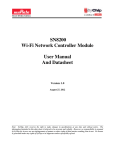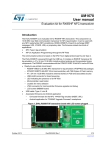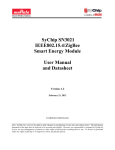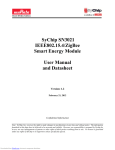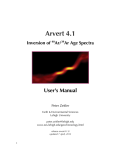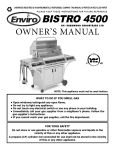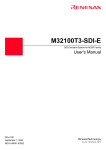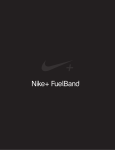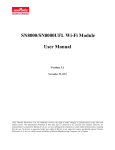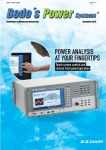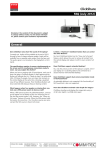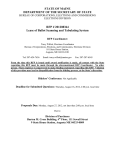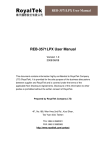Download 8106 type ME Data Sheet
Transcript
SN8200 Wi-Fi Network Controller Module User Manual And Datasheet Version: 1.2 May 30, 2013 Note: SyChip, LLC. reserves the right to make changes in specifications at any time and without notice. The information furnished in this data sheet is believed to be accurate and reliable. However, no responsibility is assumed by SyChip for its use, nor any infringements of patents or other rights of third parties resulting from its use. No license is generated under any rights of SyChip or its supporters unless specifically agreed. Revision History Revision Date Author Change Description 0.1 12/09/2012 Y. Fang Initial version 0.5 02/03/2012 Y. Fang Preliminary version 0.6 2/20/2012 N. Nagayama 0.7 04/20/2012 J. Gregus 1.0 08/27/2012 Y. Fang Formal Release 1.1 01/23/2013 Y. Fang Added Power Rail Current Specification and Standby Mode Current Consumption 1.2 05/30/2013 R. Willett Changed specs in Table 1 for Pin 2, 3, 4, and 30 Update performance data and adjusted table format Update CE compliance information Page 2 of 30 SN8200 User Manual and Datasheet v1.2 Table of Contents 1 SYSTEM DESCRIPTIONS ..................................................................................................................................... 6 1.1 1.2 1.3 1.4 2 MECHANICAL SPECIFICATIONS ..................................................................................................................... 8 2.1 2.2 2.3 2.4 3 DC/RF CHARACTERISTICS FOR IEEE 802.11B ..................................................................................................... 14 DC/RF CHARACTERISTICS FOR IEEE 802.11G ..................................................................................................... 15 DC/RF CHARACTERISTICS FOR IEEE 802.11N ..................................................................................................... 16 ENVIRONMENTAL SPECIFICATIONS ........................................................................................................... 17 5.1 5.2 6 TYPICAL POWER CONSUMPTION........................................................................................................................... 13 RF SPECIFICATIONS .......................................................................................................................................... 14 4.1 4.2 4.3 5 MODULE DIMENSION .............................................................................................................................................. 8 MODULE TOP AND SIDE VIEW ................................................................................................................................. 8 MODULE FOOTPRINT (TOP VIEW) ............................................................................................................................ 9 MODULE PIN-OUT................................................................................................................................................. 10 DC ELECTRICAL SPECIFICATIONS .............................................................................................................. 13 3.1 4 APPLICATIONS ........................................................................................................................................................ 6 MODULE SUMMARY ............................................................................................................................................... 6 BLOCK DIAGRAM ................................................................................................................................................... 7 ACRONYMS............................................................................................................................................................. 7 ABSOLUTE MAXIMUM RATINGS ............................................................................................................................ 17 RECOMMENDED OPERATING CONDITIONS ............................................................................................................ 17 APPLICATION INFORMATION........................................................................................................................ 18 6.1 EXTERNAL DIGITAL INTERFACES .......................................................................................................................... 18 6.1.1 Reference connection for UART host interface .......................................................................................... 18 6.1.2 Reference connection for the SPI host interface ........................................................................................ 19 6.2 RECOMMENDED HOST (CUSTOMER) CIRCUIT BOARD PCB PATTERN ..................................................................... 20 6.3 HOST PCB LAYOUT RECOMMENDATIONS ............................................................................................................. 20 6.4 MODULE LOCATION ............................................................................................................................................. 21 6.4.1 Location in x-y plane .................................................................................................................................. 22 6.4.2 Location in z-plane ..................................................................................................................................... 22 7 ASSEMBLY INFORMATION ............................................................................................................................. 23 7.1 8 LEAD-FREE SOLDERING REFLOW PROFILE ............................................................................................................. 23 PACKAGING AND MARKING INFORMATION ............................................................................................ 24 8.1 8.2 CARRIER TAPE DIMENSIONS ................................................................................................................................. 24 MODULE MARKING INFORMATION ....................................................................................................................... 24 9 ORDERING INFORMATION ............................................................................................................................. 25 10 ROHS DECLARATION ........................................................................................................................................ 25 11 REGULATORY INFORMATION ....................................................................................................................... 25 11.1 11.2 11.3 11.4 11.5 11.6 FCC NOTICE (USA) ........................................................................................................................................ 25 FCC LABELING REQUIREMENTS ...................................................................................................................... 26 RF EXPOSURE .................................................................................................................................................. 26 IC NOTICE (CANADA) ...................................................................................................................................... 26 IC LABELING REQUIREMENTS ......................................................................................................................... 27 CE NOTICE (EUROPE) ...................................................................................................................................... 27 Page 3 of 30 SN8200 User Manual and Datasheet v1.2 11.7 CE LABELING REQUIREMENTS ........................................................................................................................ 27 12 TECHNICAL SUPPORT CONTACT ................................................................................................................. 28 13 DISCLAIMER ........................................................................................................................................................ 28 Page 4 of 30 SN8200 User Manual and Datasheet v1.2 LIST OF FIGURES FIGURE 1 SN8200 MODULE BLOCK DIAGRAM ..................................................................................................................... 7 FIGURE 2 MODULE TOP AND SIDE VIEW .............................................................................................................................. 8 FIGURE 3 DETAILED MECHANICAL DATA (TOP VIEW) .......................................................................................................... 9 FIGURE 4 UART HOST INTERFACE REFERENCE DIAGRAM ................................................................................................. 18 FIGURE 5 SPI HOST INTERFACE REFERENCE DIAGRAM ...................................................................................................... 19 FIGURE 6 RECOMMENDED HOST (CUSTOMER) PCB PATTERN ............................................................................................ 20 FIGURE 7 RECOMMENDED HOST CIRCUIT BOARD DESIGN UNDERNEATH THE MODULE ..................................................... 21 FIGURE 8 RECOMMENDED LOCATIONS IN XY-PLANE .......................................................................................................... 22 FIGURE 9 LOCATIONS NOT RECOMMENDED IN XY-PLANE .................................................................................................. 22 FIGURE 10 RECOMMENDED LOCATIONS IN Z-PLANE ........................................................................................................... 22 FIGURE 11 LOCATIONS NOT RECOMMENDED IN XY-PLANE ................................................................................................ 22 FIGURE 12 REFLOW PROFILE PATTERN .............................................................................................................................. 23 FIGURE 13 CARRIER TAPE DIMENSIONS ............................................................................................................................. 24 FIGURE 14 MODULE MARKING DETAIL ............................................................................................................................. 24 LIST OF TABLES TABLE 1 MODULE CONNECTOR SIGNAL DESCRIPTION ...................................................................................................... 10 TABLE 2 TYPICAL POWER CONSUMPTION .......................................................................................................................... 13 TABLE 3 RF CHARACTERISTICS FOR IEEE 802.11B ........................................................................................................... 14 TABLE 4 RF CHARACTERISTICS FOR IEEE 802.11G............................................................................................................ 15 TABLE 5 RF CHARACTERISTICS FOR IEEE 802.11N............................................................................................................ 16 TABLE 6 ABSOLUTE MAXIMUM RATING ............................................................................................................................ 17 TABLE 7 RECOMMENDED OPERATING CONDITIONS ........................................................................................................... 17 TABLE 8 REFLOW PROFILE RECOMMENDATION ................................................................................................................. 23 Page 5 of 30 SN8200 User Manual and Datasheet v1.2 1 System Descriptions 1.1 Applications SN8200 is a complete low power self-contained embedded wireless solution to address the connectivity demand in M2M applications. It integrates micro-controller, Wi-Fi BB/MAC/RF IC, RF front end, clocks, and on-board antenna into a small form factor module. SN8200 can be controlled by a host device through a serial interface; it can also serve as a standalone Wi-Fi station or network controller. Thus, it can be used to enable wireless connectivity to the simplest products with minimal engineering resources. The SN8200 provides standard IEEE802.11 b/g/n functions. The integrated MCU supports Broadcom WICED™ software. It can be used for a variety of different applications, such as wireless sensor node, serial to Wi-Fi transceiver, Wi-Fi network controller, Wi-Fi gateway/bridges plus internet server. When used in a system where the SN8200 is controlled by a host CPU, the serial host interface makes it very easy to integrate. When used in a system without a host CPU, the integrated ARM Cortex-M3 can be used to run a variety of applications. The SN8200 Wi-Fi module can be used for Wi-Fi gateway if combined with other radio module. For example, one can design a Zigbee Wi-Fi gateway by combine SN8200 with SyChip SN3020 Zigbee module. SyChip provides a reference design to enable the OEM customer. This gateway design can be used for low cost and low power consumption applications like Home Area Networks. 1.2 Module Summary • 2.4GHz IEEE 802.11b/g/n radio technology • Dimension: 30.5 mm × 19.4 mm × 2.8 mm • On-board antenna • Transmit power: +18 dBm @ 11b /11Mbps • Max receive sensitivity: -96dBm • MCU: ARM Cortex-M3 • Diverse serial interface: UART, SPI • Sensor applications support: ADC, DAC, I2C, GPIO • Operating temperature range: -30ºC to 85ºC • RoHS compliant • MSL Level 3 • FCC/IC certified; CE compliant Page 6 of 30 SN8200 User Manual and Datasheet v1.2 1.3 Block Diagram Figure 1 SN8200 Module Block Diagram 1.4 Acronyms ADC Analog to Digital Converter GPIO General-Purpose Input-Output I2C Intelligent Interface Controller ISM Industrial, Scientific and Medical MAC Medium Access Control MSL Moisture Sensitivity Level PER Packet Error Rate ROHS Restriction of Hazardous Substances SPI Serial Peripheral Interface UART Universal Asynchronous Receiver-Transmitter Page 7 of 30 SN8200 User Manual and Datasheet v1.2 2 Mechanical Specifications 2.1 2.2 Module dimension Parameter Typical Units Dimension (LxWxH) Dimension tolerances (LxWxH) 30.5 x 19.4 x 2.8 ±0.2 mm mm Module top and side view Figure 2 Module Top and Side View Page 8 of 30 SN8200 User Manual and Datasheet v1.2 2.3 Module footprint (top view) Figure 3 Detailed Mechanical Data (top view) Page 9 of 30 SN8200 User Manual and Datasheet v1.2 2.4 Module Pin-out Table 1 Module Connector Signal Description Pin # 1 2 Pin name GND OSC32_IN I/O - Description Ground I/O Optional precision 32.768 kHz slow clock input. No connect if not used 3 OSC32_OUT I/O No connect 4 WIFI_VDD_EN I/O No connect 5 ADC3 I/O General purpose I/O or ADC3 6 ADC4 I/O General purpose I/O or ADC4 7 ADC5 I/O General purpose I/O or ADC5 8 VDD PI DC supply for MCU and I/O 9 ADC6 I/O General purpose I/O or ADC6 10 DAC2 I/O General purpose I/O or DAC2 11 DAC1 I/O General purpose I/O or DAC1 12 ADC1 I/O General purpose I/O or ADC1 13 Reserved - No connect 14 Reserved - No connect 15 GND - Ground 16 GND - Ground 17 GND - Ground 18 GND - Ground 19 GND - Ground 20 GND - Ground 21 GND - Ground 22 GND - Ground 23 GND - Ground 24 GND - Ground 25 GND - Ground 26 VDD_WIFI_IN PI Wi-Fi power supply 27 Reserved - No connect 28 Reserved - No connect 29 Reserved - No connect 30 WIFI_SLEEP_CLK_IN I Optional precision 32.768 kHz Wi-Fi sleep Page 10 of 30 SN8200 User Manual and Datasheet v1.2 Pin # Pin name I/O Description clock input. Tie to GND if not used 31 GND 32 UART_TX I/O General purpose I/O or UART_TX 33 UART_RX I/O General purpose I/O or UART_RX 34 UART_CTS I/O General purpose I/O or UART_CTS 35 UART_RTS I/O General purpose I/O or UART_RTS 36 JTMS I/O General purpose I/O or JTMS 37 JTDI/SPI_NSS I/O General purpose I/O or JTDI or SPI_NSS 38 JTCK I/O General purpose I/O or JTCK 39 Ground 40 JTDO/SPI_SCK I/O General purpose I/O or JTDO or SPI_SCK 41 JTRST/SPI_MISO I/O General purpose I/O or JTRST or SPI_MISO 42 SPI_MOSI I/O General purpose I/O or SPI_MOSI 43 I2C_SCL I/O General purpose I/O or I2C_SCL 44 I2C_SDA I/O General purpose I/O or I2C_SDA 45 - BOOT 46 ADC2 47 MICRO_RST_N 48 - VBAT I/O Ground Ground Normal operation if connected to ground at power up. General purpose I/O or ADC2 I Module reset PI Power supply for backup circuitry when VDD is not present 49 GND - Ground 50 GND - Ground 51 GND - Ground 52 GND - Ground 53 GND - Ground 54 GND - Ground 55 GND - Ground 56 GND - Ground 57 GND - Ground 58 GND - Ground 59 GND - Ground 60 GND - Ground Page 11 of 30 SN8200 User Manual and Datasheet v1.2 Pin # Pin name I/O Description 61 Reserved - No connect 62 GND - Ground Page 12 of 30 SN8200 User Manual and Datasheet v1.2 3 DC Electrical Specifications 3.1 Typical Power Consumption Condition: 25C, includes both Wi-Fi chip and microcontroller Table 2 Typical Power Consumption Values Item Min Receive mode 11b Transmit mode (18dBm/ 100% Duty Cycle) 11Mbps Receive mode 11g Transmit mode (14.5 dBm/ 100 % Duty Cycle) Transmit mode (13.5dBm/ 100% Duty Cycle) Typ Max 110 mA 370 mA 110 mA 290 mA 110 mA 280 mA 54Mbps Receive mode 11n Units Condition MCS7 Standby Mode with IEEE802.11 Power Save DTIM 1, Telnet session established and idling 3.15 mA Standby Mode with IEEE802.11 Power Save DTIM 3, Telnet session established and idling 1.28 mA Page 13 of 30 SN8200 User Manual and Datasheet v1.2 4 RF Specifications 4.1 DC/RF Characteristics for IEEE 802.11b Conditions: 25deg.C, VDD_WIFI_IN=3.6V, VDD= 3.3V (11Mbps mode unless otherwise specified.) Measured at 50Ω terminal load connected to the RF connector Table 3 RF Characteristics for IEEE 802.11b Parameters Specification Modulation DSSS/CCK Physical layer data rate 1,2,5.5,11Mbps RF Characteristics Min Typ. Max. Unit Frequency range 2400 -- 2483.5 MHz Carrier frequency error -20 -- +20 ppm Transmit output power 16 18 20 dBm -- -- -30 dBr -- -- -50 dBr Power-on and Power-down ramp -- -- 2 usec RF Carrier Suppression 15 -- -- dBc Modulation accuracy (EVM) -- -- 35 % 30MHz to 1GHz (BW=100KHz) -96 dBm 1GHz to 12.75GHz (BW=1MHz) -41 dBm 1.8GHz to 1.9GHz (BW=1MHz) -65 dBm 5.15GHz to5.3GHz (BW=1MHz) -85 dBm Spectrum mask 1st side lobes nd 2 side lobes Outband spurious emissions Receive Minimum Sensitivity 1Mbps (FER≤ 8%) -94 -96 -- dBm 11Mbps (FER≤ 8%) -86 -88 -- dBm Maximum input level (FER≤ 8%) -9.5 -- -- dBm Adjacent channel rejection (FER≤ 8%) 35 dB [Note] 1. Derate by 1.5 dB for temperatures less than -10C or more than 55C in transceiver mode. 2. Derate by 1.5 dB for temperatures less than-30C to -10C and 55C to 85C in receiver mode. Page 14 of 30 SN8200 User Manual and Datasheet v1.2 4.2 DC/RF Characteristics for IEEE 802.11g Conditions: 25deg.C, VDD_WIFI_IN=3.6V, VDD= 3.3V (54Mbps mode unless otherwise specified.) Measured at 50Ω terminal load connected to the RF connector Table 4 RF Characteristics for IEEE 802.11g Parameters Specification Standard conformance IEEE 802.11 g Modulation OFDM Data rate 6, 9, 12, 18, 24, 36, 48, 54Mbps RF Characteristics Min Typ. Max. Unit Frequency range 2400 -- 2483.5 MHz Carrier frequency error -20 -- +20 ppm Transmit output power 12.5 14.5 16.5 dBm Spectrum mask 9MHz to 11MHz (0dB ~ -20dB) 0 - dB 11MHz to 20MHz (-20dB ~ -28dB) 0 - dB 20MHz to 30MHz (-28dB ~ -40dB) 0 - dB 30MHz to 33MHz (-40dB) 0 - dB -25 dB 30MHz to 1GHz (BW=100KHz) -96 dBm 1GHz to 12.75GHz (BW=1MHz) -41 dBm 1.8GHz to 1.9GHz (BW=1MHz) -65 dBm 5.15GHz to5.3GHz (BW=1MHz) -85 dBm Constellation Error (EVM) -- -- Outband spurious emissions Received Minimum Sensitivity 6Mbps (PER≤ 10%) -87 -89 -- dBm 54Mbps (PER ≤ 10%) -72 -74 -- dBm Maximum input level (PER ≤ 10%) -13 -- -- dBm Adjacent channel rejection (PER ≤ 10%) -1 dB [Note] 1. Derate by 1.5 dB for temperatures less than -10C or more than 55C in transceiver mode. 2. Derate by 1.5 dB for temperatures less than-30C to -10C and 55C to 85C in receiver mode. Page 15 of 30 SN8200 User Manual and Datasheet v1.2 4.3 DC/RF Characteristics for IEEE 802.11n Conditions: 25deg.C, VDD_WIFI_IN=3.6V, VDD= 3.3V (65Mbps mode unless otherwise specified.) Measured at 50Ω terminal load connected to the RF connector Table 5 RF Characteristics for IEEE 802.11n Parameters Specification Standard conformance IEEE 802.11 n Modulation OFDM Data rate 6.5, 13, 19.5, 26, 39, 52, 58.5, 65Mbps RF Characteristics Min Typ. Max. Unit Frequency range 2400 -- 2483.5 MHz Carrier frequency error -20 -- +20 Ppm Power level 11 13 15 dBm Spectrum mask 9MHz to 11MHz (0dB ~ -20dB) 0 - dB 11MHz to 20MHz (-20dB ~ -28dB) 0 - dB 20MHz to 30MHz (-28dB ~ -45dB) 0 - dB 30MHz to 33MHz (-45dB) 0 - dB -28 dB 30MHz to 1GHz (BW=100KHz) -96 dBm 1GHz to 12.75GHz (BW=1MHz) -41 dBm 1.8GHz to 1.9GHz (BW=1MHz) -65 dBm 5.15GHz to5.3GHz (BW=1MHz) -85 dBm -- dBm Constellation Error (EVM) -- -- Outband spurious emissions Received Minimum Sensitivity 65Mbps (PER ≤ 10%) -69 -71 Maximum input level (PER ≤ 10%) -13 dB Adjacent channel rejection (PER ≤ 10%) -2 dB [Note] 1. Derate by 1.5 dB for temperatures less than -10C or more than 55C in transceiver mode. 2. Derate by 1.5 dB for temperatures less than-30C to -10C and 55C to 85C in receiver mode. Page 16 of 30 SN8200 User Manual and Datasheet v1.2 5 Environmental Specifications 5.1 Absolute maximum ratings Table 6 Absolute Maximum Rating Symbol 5.2 Description Min Max Unit Top Operating temperature -30 85 °C Tst Storage temperature -40 85 °C VDD Power supply 0 4.0 V VBAT Power supply for backup circuitry when VDD is not present 0 4.0 V VDD_WiFi Wi-Fi Power supply 0 6.0 V RFin RF input power 0 dBm MSL Moisture Sensitivity Level RoHS Restriction of Hazardous Substances 3 Compliant Recommended Operating Conditions Table 7 Recommended Operating Conditions VDD VBAT VDD_WiFi Min (V) Typical (V) Max (V) 2.4 2.0 3.4 3.3 3.3 3.6 3.6 3.6 4.0 Page 17 of 30 Supply Current Specification (mA) 150 10 500 SN8200 User Manual and Datasheet v1.2 6 Application Information 6.1 External digital interfaces 6.1.1 Reference connection for UART host interface Figure 4 illustrates the connections between SN8200 module and the host MCU via UART interface. A level shifter may be needed if the host UART interface level does not match with SN8200. Figure 4 UART Host Interface Reference Diagram Page 18 of 30 SN8200 User Manual and Datasheet v1.2 6.1.2 Reference connection for the SPI host interface Figure 5 illustrates the connections between SN8200 module and the host MCU via SPI interface. Figure 5 SPI Host Interface Reference Diagram Page 19 of 30 SN8200 User Manual and Datasheet v1.2 6.2 Recommended host (customer) circuit board PCB pattern Figure 6 Recommended Host (customer) PCB Pattern 6.3 Host PCB layout recommendations The SN8200 module has an onboard antenna therefore it requires careful host PCB layout underneath the module such that the radio can achieve its best RF performance. Refer to Figure 7 for the requirements. Page 20 of 30 SN8200 User Manual and Datasheet v1.2 Figure 7 Recommended Host Circuit Board Design underneath the Module Notes: 1. Due to the surface mount antenna on the module, the area in ‘Zone1’ on all layers of the customer circuit board should be free of any metal objects. Specifically, there should be no ground plane, traces or metal shield case. 2. The area in ‘Zone2’ on the top layer of the customer circuit board should have ground only with no signal traces. 6.4 Module Location For optimum EIRP, customer is advised to use the recommended module location on their host circuit board. Page 21 of 30 SN8200 User Manual and Datasheet v1.2 6.4.1 Location in x-y plane Antenna Connector No GND in this area (See Fig.8) Antenna Shield Case Figure 8 Recommended Locations in xy-plane Figure 9 Locations Not Recommended in xy-plane 6.4.2 Location in z-plane Metal Module Antenna Connector Antenna Mother Board Metal Figure 10 Recommended Locations in z-plane Metal Metal Metal Figure 11 Locations Not Recommended in xy-plane Page 22 of 30 SN8200 User Manual and Datasheet v1.2 7 Assembly Information 7.1 Lead-free soldering reflow profile The lead-free solder reflow profile is recommended in the table & graph below. The profile is used to attach the module to its host PCB. The module is designed to withstand 2 reflows. Opposite side reflow is prohibited due to the module weight. Table 8 Reflow Profile Recommendation Ramp up rate Maximum time maintained above 217oC Peak temperature Maximum time within 5oC of peak temperature Ramp down rate 3oC/second max 120 seconds 250oC 20 seconds 6oC/second max Reflow Profile Temperature, C 250 200 150 100 50 0 Time, seconds Figure 12 Reflow Profile Pattern Page 23 of 30 SN8200 User Manual and Datasheet v1.2 8 Packaging and Marking Information 8.1 Carrier Tape Dimensions Figure 13 Carrier Tape Dimensions 8.2 Module Marking Information The following marking information may be printed on a permanent label affixed to the module shield or permanently laser written into the module shield itself. The 2D barcode is used for internal purposes. A pin 1 ID is stamped into the shield. Figure 14 Module Marking Detail Page 24 of 30 SN8200 User Manual and Datasheet v1.2 9 Ordering Information Table 9 Ordering Information SyChip Model Number SyChip Part Number Standard Order Increment *Evaluation Development Kit SN8200EVK 88-00151-85 1 pc Evaluation Development Kit+ SN8200EVK+ 88-00151-95 1 pc SN8200 88-00151-00 400 pcs Product Module in Tape & Reel 10 RoHS Declaration To the best of our present knowledge, given our supplier declarations, this product does not contain substances that are banned by Directive 2002/95/EC or contain a maximum concentration of 0.1% by weight in homogeneous materials for • Lead and lead compounds • Mercury and mercury compounds • Chromium (VI) • PBB (polybrominated biphenyl) • PBDE (polybrominated biphenyl ether) And a maximum concentration of 0.01% by weight in homogeneous materials for • Cadmium and cadmium compounds 11 Regulatory Information SN8200 has obtained the certifications described below. 11.1 FCC Notice (USA) This device complies with Part 15 of the FCC rules. Operation is subject to the following two conditions: (1) this device may not cause harmful interference, and (2) this device must accept any interference received, including interference that may cause undesired operation. The FCC requires the OEM to be notified that any changes or modifications not expressly approved by SyChip, LLC may void the user’s authority to operate the equipment. While an application of the SN8200 module in a product is not required to obtain a new FCC authorization for the module, this does not preclude the possibility that some other form of authorization or testing may be required for that end product. This device using the integrated antenna has been tested to comply with FCC CFR Part 15. The device meets the requirements for modular transmitter approval as detailed in the FCC public notice DA00.1407. Page 25 of 30 SN8200 User Manual and Datasheet v1.2 This equipment has been tested and found to comply with the limits for a Class B digital device, pursuant to Part 15 of the FCC Rules. These limits are designed to provide reasonable protection against harmful interference in a residential installation. This equipment generates uses and can radiate radio frequency energy and, if not installed and used in accordance with the instructions, may cause harmful interference to radio communications. However, there is no guarantee that interference will not occur in a particular installation. If this equipment does cause harmful interference to radio or television reception, which can be determined by turning the equipment off and on, the user is encouraged to try to correct the interference by one or more of the following measures: reorient or relocate the receiving antenna, increase the separation between the equipment and receiver, connect the equipment into an outlet on a circuit different from that to which the receiver is connected, or consult the dealer or an experienced radio/TV technician for help. 11.2 FCC Labeling Requirements When integrating the SN8200 into a product the FCC labeling requirements must be met. This includes a clearly visible label on the outside of the finished product specifying the SN8200 FCC identifier (FCC ID:QPU8200) as well as the notice above. The exterior label can use wording such as “Contains Transmitter Module FCC ID:QPU8200” or “Contains FCC ID:QPU8200” although any similar wording that expresses the same meaning may be used. 11.3 RF Exposure This module has been certified for remote and base radio applications and is not intended to be operated within 20cm of the body. If the module will be used for portable applications, the device must undergo SAR testing. The following statement must be included as a CAUTION statement in manuals for the products to alert users on FCC RF exposure compliance: “WARNING: To satisfy FCC RF exposure requirements for mobile transmitting devices, a separation distance of 20cm or more should be maintained between the antenna of this device and persons during operation. To ensure compliance, operations at closer distances than this are not recommended.” 11.4 IC Notice (Canada) The term “IC” before the certification/registration number only signifies that the Industry Canada technical specifications were met. Le terme “IC” devant le numéro de certification /d’enregistrement signifie seulement que les spécifications techniques Industrie Canada ont été respectées. This device complies with Industry Canada license-exempt RSS standard(s). Operation is subject to The following two conditions: (1) this device may not cause interference, and (2) this device must accept any interference, including interference that may cause undesired operation of the device. Page 26 of 30 SN8200 User Manual and Datasheet v1.2 Cet appareil est conforme avec Industrie Canada RSS standard exempts de licence (s). Son utilisation est soumise à Les deux conditions suivantes: (1) cet appareil ne peut pas provoquer d'interférences et (2) cet appareil doit accepter Toute interférence, y compris les interférences qui peuvent causer un mauvais fonctionnement du dispositif. This device complies with Health Canada’s Safety Code 6 / IC RSS-210. The installer of this device should ensure that RF radiation is not emitted in excess of the Health Canada’s requirement. Information can be obtained at: http://www.hc-sc.gc.ca/ewh-semt/pubs/radiation/radio_guidelignes_direct-eng.php Cet appareil est conforme avec Santé Canada Code de sécurité 6 / IC RSS-210. Le programme d'installation de cet appareil doit s'assurer que les rayonnements RF n'est pas émis au-delà de l'exigence de Santé Canada. Les informations peuvent être obtenues: http://www.hc-sc.gc.ca/ewhsemt/pubs/radiation/radio_guide-lignes_direct-eng.php 11.5 IC Labeling Requirements The host device should be properly labeled to identify the module within the host device. The Industry Canada certification label of a module shall be clearly visible at all times when installed in the host device, otherwise the host device must be labeled to display the Industry Canada certification number of the module, preceded by the words “Contains transmitter module”, or the word “Contains”, or similar wording expressing the same meaning, as follows: Contains transmitter module IC:4523A-SN8200, where 4523A-SN8200 is the module’s certification number. 11.6 CE Notice (Europe) This device has been tested and certified for use in the European Union. If this device is used in a product, the OEM has responsibility to verify compliance of the final product to the EU standards. A Declaration of Conformity must be issued and kept on file as described in Annex II of the Radio and Telecommunications Terminal Equipment Directive. 11.7 CE Labeling Requirements The ‘CE’ mark must be placed on the OEM product per the labeling requirements of the Directive. Given that the operating frequency band is not harmonized by a few European countries, the restriction or alert sign must be placed alongside the ‘CE’ mark as shown below. As of the date of this document, only France has a restriction. The restriction is that, if the radio is operated outdoors in the 2450-2483.5 MHz band, the power must be limited to 10 mW instead of 100 mW. The OEM must account for this and the product must have the alert mark. It does not require country notifications, however. Page 27 of 30 SN8200 User Manual and Datasheet v1.2 12 Technical Support Contact SyChip LLC 2805 Dallas Parkway, Suite 400 Plano, TX 75093 USA Tel: (972) 202-8900 Fax: (972) 633-0327 Note: SyChip LLC is an operating unit within Murata Wireless Solutions 13 Disclaimer Please read this notice before using the SN8200 product. 1. Please note that the only warranty that SyChip LLC (“SyChip”) provides regarding the products is its conformance to the specifications provided herein. Accordingly, SyChip shall not be responsible for any defects in products or equipment incorporating such products, which are caused under the conditions other than those specified in this specification. SYCHIP HEREBY DISCLAIMS ALL OTHER WARRANTIES REGARDING THE PRODUCTS, EXPRESS OR IMPLIED, INCLUDING WITHOUT LIMITATION ANY WARRANTY OF FITNESS FOR A PARTICULAR PURPOSE, THAT THEY ARE DEFECT-FREE, OR AGAINST INFRINGEMENT OF INTELLECTUAL PROPERTY RIGHTS. YOU AGREE TO INDEMNIFY AND DEFEND SYCHIP AND ITS AFFILIATES AGAINST ALL CLAIMS, DAMAGES, COSTS AND EXPENSES THAT MAY BE INCURRED, INCLUDING WITHOUT LIMITATION, ATTORNEY FEES AND COSTS, DUE TO THE USE OF PRODUCTS. 2. The product is designed and manufactured for general applications, and not for any particular application, so testing and use of the product shall be conducted at your own risk and responsibility. Specifically, please observe the following: i) Please conduct validation and verification of the products in actual condition of mounting and operating environment before commercial shipment of the equipment. ii) Please pay attention to minimize any mechanical vibration or shock, not to drop the product or a substrate that contains the product during transportation. iii) Since the application of static electricity or overvoltage may cause a defect in the product or deterioration of its reliability, caution must be taken against exposure to any static electricity generated by electrified items such as work benches, soldering irons, tools, carrying containers, etc. iv) Caution shall be taken to avoid overstress to the product during and after the soldering process. Page 28 of 30 SN8200 User Manual and Datasheet v1.2 v) Since the applied soldering method may deteriorate the reliability, thorough evaluation is recommended. vi) In case the product is to be used in equipment or electric circuit that requires high safety or reliability function or performance, sufficient reliability evaluation checks for safety shall be performed before commercial shipment and moreover, due consideration to install a protective circuit is strongly recommended at customer's design stage. Please provide an appropriate fail-safe function on your product to prevent any damages that may be caused by the abnormal function or the failure of our product. Notwithstanding the foregoing, the product shall not be used in any application listed below which requires especially high reliability for the prevention of such defect as may directly cause damage to the third party's life, body or property. - Aircraft equipment - Aerospace equipment - Undersea equipment - Power plant control equipment - Medical equipment - Transportation equipment (vehicles, trains, ships, etc.) - Traffic signal equipment - Disaster prevention / crime prevention equipment - Application of similar complexity and/or reliability requirements to the applications listed in the above. 3. SyChip’s warranty as provided in Clause 1 above that the products comply with descriptions expressly specified in the specifications shall be effective for a period of six (6) months from the date of delivery. SyChip shall not be liable for any defects that occur in dry packed products that are installed more than six (6) months after shipment. SyChip’s liability under this warranty shall be limited to products that are returned during the warranty period to the address designated by SyChip and that are determined by SyChip not to conform to such warranty. If SyChip elects to repair or replace such products, SyChip shall have reasonable time to repair such products or provide replacements. Repaired products shall be warranted for the remainder of the original warranty period. Replaced products shall be warranted for a new full warranty period. For avoidance of doubt, SyChip shall not be liable for any defects that are caused by neglect, misuse or mistreatment by an entity other than SyChip including improper installation or testing, or for any products that have been altered or modified in any way by an entity other than SyChip. Moreover, SyChip shall not be liable for any defects that result from your or third party’s design, specifications or instructions for such products. Page 29 of 30 SN8200 User Manual and Datasheet v1.2 4. Testing and other quality control techniques are used to the extent SyChip deems necessary. Unless mandated by government requirements, SyChip does not necessarily test all parameters of each product. 5. End of Life - Please note that we may discontinue the manufacture of products, due to reasons such as, but not limited to, end of supply of materials and/or components from our suppliers. Page 30 of 30 SN8200 User Manual and Datasheet v1.2 Mouser Electronics Authorized Distributor Click to View Pricing, Inventory, Delivery & Lifecycle Information: Murata: 88-00151-85
































